#womens suffrage
Text

USIA poster, 7/30/1953, NARA ID 5730043.
VOTE ON TUESDAY!
The 2022 midterm elections will be held on Tuesday, November 8, and there's still time to ensure you're registered to vote. The National Archives supports Executive Order 14019, which promotes voter registration, participation, and access to voting. See Vote.gov for more information.

USIA poster 10/8/1951, NARA ID 5730163.
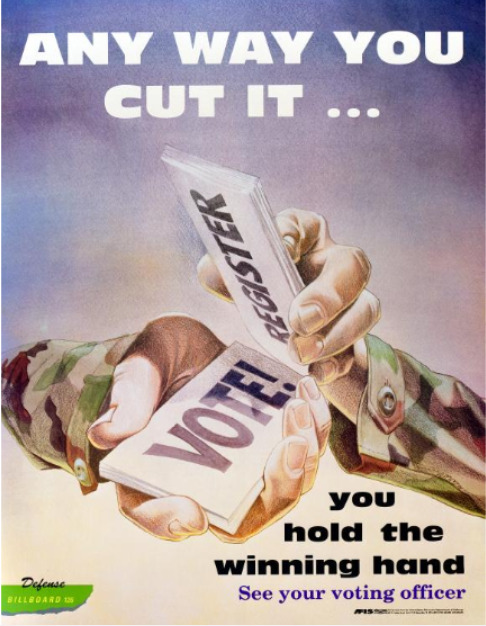
American Forces Information Service poster, 1/1/2000, NARA ID 10488372.
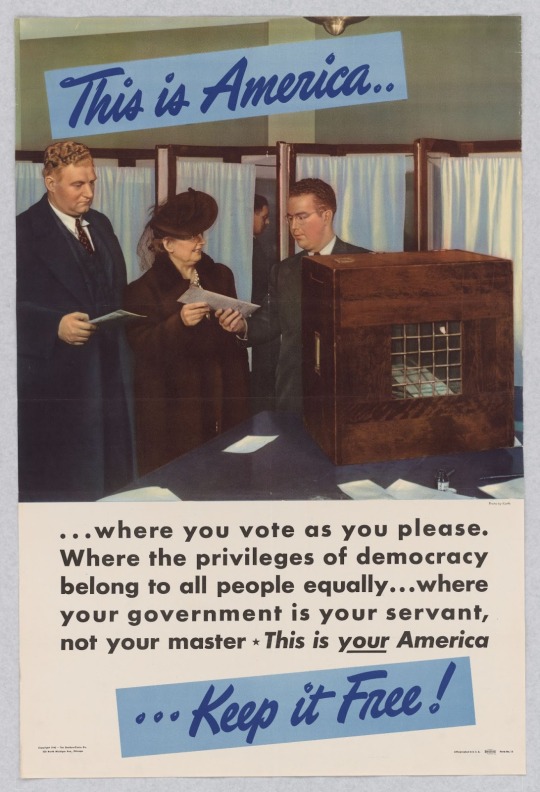
Office of War Information, WW2 poster, NARA ID 515775.

More online:
Civics for All of US the National Archives new education initiative promotes civic literacy and engagement.
Voting Rights Special Topics page.
Presidential Elections & Inaugurations Records in the National Archives and Presidential Libraries document elections and inaugurations through history.
Black Americans and the Vote This research portal highlights National Archives holdings that relate to the long struggle for equality in voting rights.
Women's Rights: Suffrage Discover an array of records related to the long quest for women to gain the vote as well as education resources, articles, and blog posts.
Online exhibit: Records of Rights presents records in the National Archives that document the ongoing struggle of Americans to define, attain, and protect their rights
Online exhibit: Rightfully Hers: American Women and the Vote highlights the struggle of diverse activists throughout U.S. history to secure voting rights for all American women.
#vote#gotv#elections#election history#womens suffrage#rightfullyhers#civil rights#nationalvoterregistration#election day#2022 midterms#us elections#patriotism#patriotic
2K notes
·
View notes
Text


People really are short sighted and selfish, huh.
212 notes
·
View notes
Text
Why were women of the present cut off from women of the past and how was this achieved? While we had been ready to believe the lessons of our own education and to accept that there was but a handful of women in the past who had protested against male power, that they were ‘eccentric’ at best, and more usually ‘neurotic’, ‘embittered’ and quite unrepresentative, then the absence of women's voices from history seemed understandable. But when it began to appear that there had been many women who had been saying in centuries past what we were saying in the 1970s, that they had been representative of their sex, and that they had disappeared, the problem assumed very different proportions.
For years I had not thought to challenge the received wisdom of my own history tutors who had — in the only fragment of knowledge about angry women I was ever endowed with — informed me that early in the twentieth century, a few unbalanced and foolish women had chained themselves to railings in the attempt to obtain the vote. When I learnt, however, that in 1911 there had been twenty-one regular feminist periodicals in Britain, that there was a feminist book shop, a woman's press, and a women's bank run by and for women, I could no longer accept that the reason I knew almost nothing about women of the past was because there were so few of them, and they had done so little. I began to acknowledge not only that the women's movement of the early twentieth century was bigger, stronger and more influential than I had ever suspected, but that it might not have been the only such movement. It was in this context that I began to wonder whether the disappearance of the women of the past was an accident.
Dale Spender, Women of Ideas and What Men Have Done to Them
#dale spender#first wave feminism#patriarchy in education#womens suffrage#women’s movement#patriarchy#knowledge suppression
374 notes
·
View notes
Text

Happy Women’s Equality Day!🚺🗳️🚺
🇺🇸
The Vote is one of the most powerful right we have, never take it for granted or let your vote be used against your own or other sisters interests!
🇺🇸
#history#women’s equality day#wyoming#united states#vote#womens history#american west#democracy#politics#congress#american history#feminism#womens suffrage#voting rights#womens equality#political parties#usa#womens rights#american politics#wild west#feminist#late 1800s#women empowerment#statehood#nickys facts
106 notes
·
View notes
Text


Resolution of the Nevada Suffrage Ratification Committee of the National American Woman Suffrage Association
Record Group 46: Records of the U.S. SenateSeries: Petitions and Related Documents That Were Presented, Read, or TabledFile Unit: Petitions and Memorials, Resolutions of State Legislatures, and Related Documents which were Presented, Read, or Tabled during the 65th Congress
handwritten at top of document binder] 33 S Return uncut! [document is typed] Assembly Joint and concurrent Resolution No. [No. is marked through by hand] [handwritten] )-ec center [handwritten] fe WHEREAS, there is now pending before the Senate of the United States a resolution to submit to the several states an amendment to the Constitution of the United States, granting the right of suffrage to women; and [handwritten] fe WHEREAS, the President of the United States has urged the passage of such resolution, not only as an act of justice to the women of America, but as a means of encouraging the acceptance of democratic ideals throughout the civilized world; and WHEREAS, the world war laid its burdens and sacrifices with even hand upon men and women alike, and demanded and received from both the fullest measure of patriotism and devotion, in order that the great purposes for which the war was successfully fought might be permanently secured for the benefit of mankind; and WHEREAS, in the period of re-adjustment and re-construction, upon which we have entered, there will arise the most difficult and far-reaching moral, social, economic, industrial and political problems that must, of necessity, affect the lives of all our people for generations to come, and in the solution of which men and women must equally be concerned; [handwritten line connecting concerned; to THEREFORE] THEREFORE, BE IT [handwritten paragraph symbol] ¶ RESOLVED by the Assembly, the Senate concurring, that the Senate of the United States be hereby requested to immediately pass such resolution to submit to the states for their approval the Susan B. Anthony Amendment to the Constitution of the United States; and [handwritten curved line] [handwritten] overBE IT FURTHER RESOLVED that the Senators from Nevada be requested to present this resolution to the United States Senate and to energetically and actively support the resolution submitting such amendment. [handwritten] St [illegible] [handwritten signatures] Helen I. Belford Sadie D Hurst Mrs I. B. Church Emma G. Vanderhuth Mrs. W. H. Hood Mrs. Mark. Walsen Mrs. F. G. Patrick Fannie U. McKenzie Mrs. C. H. [illegible] Mrs. R. D. Eichelberger Mrs. W. H. Bray Mrs. Christina W. Clark Mrs. Tegmen M Daniel (Mrs) O. H. Mack Mary [illegible] Mary A Boyd [handwritten curved line] [handwritten] Nevada Suffrage Ratification Committee of the National American Woman Suffrage Association Endorsed by The Woman Citizens Club of Reno Nevada
23 notes
·
View notes
Text
I've occasionally posted old women's suffrage (and anti-suffragette) postcards, of which there were quite a few. There's a new (to me) online collection available that has some fascinating things.
19 notes
·
View notes
Text
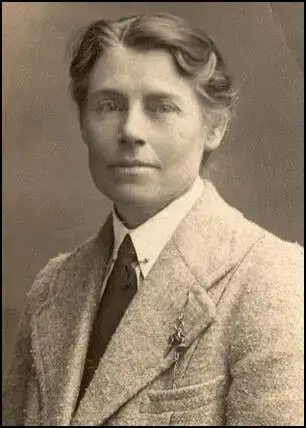



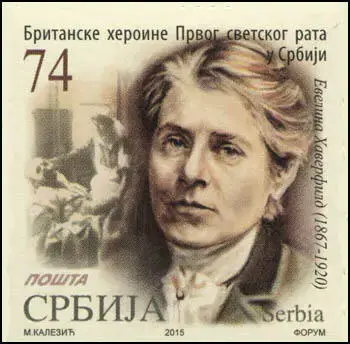
The leading Scottish suffragette, Evelina Haverfield, was born at Inverlochy Castle on August 9th 1867.
Evelina’s birth is recorded as ‘Honourable Evilena Scarlett’, she took the name Haverfield from her husband. Her childhood was divided between London and the Inverlochy estate. In 1880 she went to school in Dusseldorf, Germany, after which she married Major Henry Haverfield at the age of 19., who was 20 years her senior. The marriage is said to have been a happy one they had two sons together, The Major however died in 1896. Evelina married again two years later, a another military man, Major John Blaguy. This was not a happy union and after some time they drifted apart. The rest of her life was informed by devotion to a cause.
She became an enthusiastic supporter of the suffragette movement and was arrested during suffragette demonstrations in London for hitting an escorting police officer. Her only regret was not hitting him hard enough, promising to bring a revolver next time. During that heady time she met Vera Holme. Their companionship was to last the rest of her days.
At the outbreak of the First World War the suffragettes supported the war effort by founding a Women’s Voluntary Emergency Corps and a Women’s Voluntary Reserve Ambulance Corps. Evelina became commandant in chief of the latter, looking, it was said, every inch a soldier in her khaki uniform, although she later left after a disagreement of an undisclosed nature.
Evelina joined the Scottish Women’s Hospitals and devoted the next two years to overseas service with them. She served in Serbia with Elsie Inglis, as a hospital administrator and was part of a small group taken prisoner when the armies of the Central Powers overran Serbia in October and November 1915.
Under appalling conditions of poverty and military oppression, Evelina and those with her, struggled heroically through the winter to provide food and basic care for their wounded Serbian patients and some of the local civilian population. In the spring of 1916, Evelina and the other 'Scottish Women’ were released through the International Red Cross and returned to England.
In August 1916 Evelina went to Romania in charge of 18 ambulance and transport vehicles as part of two units of the Scottish Women’s Hospitals. These units were in support of Serbian soldiers fighting on the eastern Allied front. The stronger enemy invading armies drove the Russian, Romanian, and Serbian defenders out of southern Romania and north of the Danube river delta.
During this two-month retreat by the Allied forces, Evelina and the transport drivers were working non-stop under constant enemy fire, in desperate situations, while rescuing wounded soldiers and driving them to safety.
By early 1917, with the fighting on the eastern front over, and unable to return to Serbia because of the enemy occupation there, Evelina returned to England, where she remained until after the Armistice of November 1918. In England she raised money for clothing and canteens for Serbian soldiers, gave public speeches on behalf of Serbian relief, and helped to found a Serbian Red Cross Society in Britain.
After the Armistice she returned to Serbia to supervise the distribution of much needed food, clothing, and medical supplies. When this was done, in 1919, she made plans to found a home for Serbian war orphans in a Serbian mountain village. It was there, in Baijna Bashta, that she contracted pneumonia, probably brought on by overwork and fatigue, and died prematurely at the age of 52, revered and honoured by the Serbs for her five years of humanitarian work on their behalf. The Serbs issued a stamp commemorating this remarkable women in 2015, a woman few Scots have even heard of…….
Buried in Serbia today, Evelina’s gravestone reads:
‘Hear lies the body of the honourable Evelina Haverfield youngest daughter of William Scarlett 3rd Baron Abinger and of Helen ne Magruder his wife of Inverloky Castle Fort William Scotland who finished her work in Bajina Bashta March 21st 1920 through the war 1914-1920 She worked for the Serbian people with untiring zeal. A straight fighter as traight rider and a most loyal friend. R.I.P’
In 2015 Evalina was one of five Scottish women and one English women, who worked as doctors, nurses and drivers feature on a series of stamps in Serbia, the others were Dr Elsie Inglis a campaigner for women's suffrage and the founder of the Scottish Women Hospitals in Serbia. Dr Inglis was one of the first female graduates at the University of Edinburgh.
Dr Elizabeth Ross, one of the first women to obtain a medical degree at the University of Glasgow. She travelled to Serbia as a volunteer and tragically passed away during the typhoid epidemic in 1915.
Dr Katherine MacPhail OBE, involved in humanitarian work in Serbia throughout WW1. She is remembered for opening the first paediatric ward in Belgrade in 1921.
Dr Isabel Emslie Galloway Hutton who joined the Scottish Women Hospitals as a volunteer in 1915 after she was turned away by the War Office in London. She served in France, Greece and Serbia until 1920.
The sixth was English woman, Captain Flora Sandes, who was the only known British female to bear arms during WW1
33 notes
·
View notes
Text
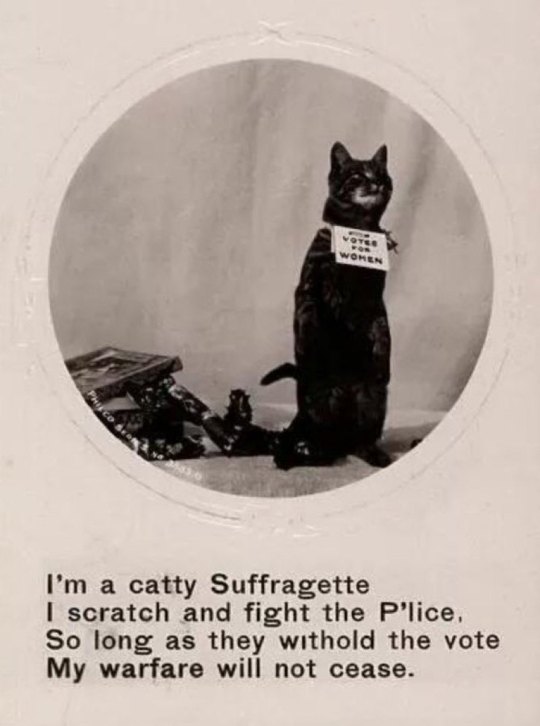
Anti-suffragists in the US and the UK used cat imagery in their materials opposing the vote for women. By the 1910s, plenty of suffragists were turning it around and embracing the cat imagery themselves.
43 notes
·
View notes
Text
It occurs to me that deep down, most people who oppose abortion rights probably aren't mad keen on womens suffrage either. If someone can't even bear the thought of a woman deciding what to do with her body then do you really think they are happy about women making decisions about how the country is run.
So you know, today it's abortion rights and thats bad enough, but tomorrow it'll be the vote they come for. Because it always has been and always will be about who holds power.
9 notes
·
View notes
Text

Starting off my first post with some art appreciation, now I only just got into analyzing paintings, and other pieces of art but when I saw Paula Rego's Abortion series for the first time, I was awe inspired.
In an interview, She spoke on how these paintings were visualizing the pain, fear, and danger of illegal or self-abortions, and how governments criminalize the women for these painful procedures. In her paintings she also does not depict the women as victims but as triumphant, by the fact they got through this pain and fear alone, even though there is humiliation at having to get the medical procedure. It shows the strength these women had to find to be able to go through with the abortion.
What also shocks me is 16 days after Paula Rego's death, The U.S. overturned Roe v. Wade!
11 notes
·
View notes
Text

Women's Suffrage Women's History Month
46 notes
·
View notes
Text
There's a discourse on Twitter right now arguing whether or not we should repeal women's suffrage in America.
So.
Yeah.
I mean to be totally fair, half of American women seem to be championing for the loss of their rights as well as the rights of their daughters and then their granddaughters but whatever right, this might as well happen.
153 notes
·
View notes
Text
"You have granted that woman may be hung," said Wendell Phillips to his fellowmen, and "therefore you must grant that woman may vote." It was as simple as that. Either women were the peers and equals of men, and in that case should enjoy all civil and political rights equally with them, or women were (as men repeatedly maintained) an inferior caste; and in that case, any woman tried by a jury of men was automatically deprived of the right to trial by a jury of her peers. Feminists argued that men simply could not have it both ways.
For the men the choice was no choice at all, for to concede either point was to lose ground and that would never do. The inconsistency of their position was rather embarrassing, but certainly not unbearably so considering what there was to lose to those implacable women so relentlessly consistent in their demands. The New York State Woman's Rights Committee laid out the agenda at the Tenth National Woman's Rights Convention in 1860: "We now demand the ballot, trial by jury of our peers, and an equal right to the joint earnings of the marriage copartnership. And, until the Constitution be so changed as to give us a voice in the government, we demand that man shall make all his laws on property, marriage, and divorce, to bear equally on man and woman." "A citizen can not be said to have a right to life," the feminists argued, "who may be deprived of it for the violation of laws to which she has never consented—who is denied the right of trial by a jury of her peers—who has no voice in the election of judges who are to decide her fate."
As things were, women could not get simple justice. "It is not to be denied," Elizabeth Cady Stanton argued to the New York legislature in 1854, "that the interests of man and woman in the present undeveloped state of the race, and under the existing social arrangements, are and must be antagonistic. The nobleman can not make just laws for the peasant; the slaveholder for the slave; neither can man make and execute just laws for woman, because in each case, the one in power fails to apply the immutable principles of right to any grade but his own." In the courts of law in particular, how could a woman receive just treatment from "men who, by their own admis-sion, are so coarse that women could not meet them even at the polls without contamination?" Feminists demanded "in criminal cases that most sacred of all rights, trial by jury of our own peers. The establishment of trial by jury is of so early a date," Cady Stanton explained with that reasonableness so maddening to her opponents, "that its beginning is lost in antiquity; but the right of trial by a jury of one's own peers is a great progressive step of advanced civilization... Hence, all along the pages of history, we find the king, the noble, the peasant, the cardinal, the priest, the layman, each in turn protesting against the authority of the tribunal before which they were summoned to appear. Charles the First refused to recognize the competency of the tribunal which condemned him: For how, said he, can subjects judge a king? The stern descendants of our Pilgrim Fathers refused to answer for their crimes before an English Parliament. For how, they said, can a king judge rebels? And shall woman here consent to be tried by her liege lord, who has dubbed himself law-maker, judge, juror, and sheriff too?—whose power, though sanctioned by Church and State, has no foundation in justice and equity, and is a bold assumption of our inalienable rights."
-Ann Jones, Women Who Kill
193 notes
·
View notes
Text
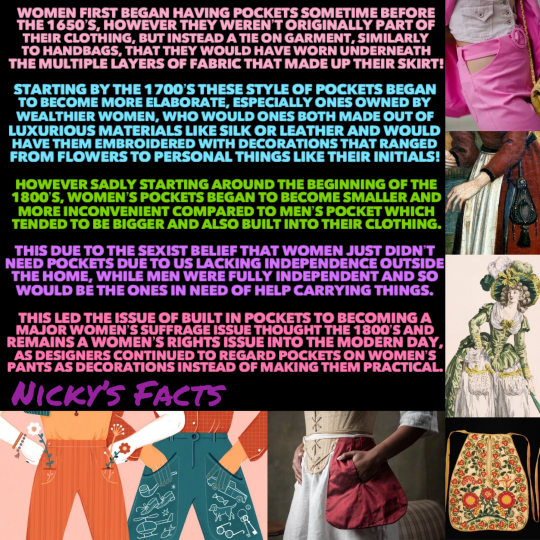
Are pockets are a symbol of are independence, one that we still have to fight for!
🚺💜🚺
#history#pocket#fashion#womens rights#historical clothing#womens history#womens suffrage#women empowerment#clothing#girl problems#fashion history#feminist#womens fashion#1700s fashion#1800s fashion#1900s fashion#feminism#womanist#sexism#women supporting women#girl power#sisterhood#feminist history#this is what makes us girls#womens rights are human rights#nickys facts
3 notes
·
View notes
Text
The Republican nominee for governor of North Carolina this year, Trump-endorsed Lt. Governor Mark Robinson, knows how to fix America’s political and social problems: prevent women from voting.
In a video from his presentation to—ironically—the Republican Women of Pitt County in March of 2020, when Robinson was successfully running for lieutenant governor, he came right out and said it:
“I absolutely want to go back to the America where women couldn’t vote,” Robinson argued. “Do you know why? Because in those days, we had people who fought for real social change, and they were called Republicans. … That’s the America we want to bring back. We want to bring back the America where Republicans and principles and true ideas of freedom rule.”
Of course, Robinson isn’t onto something new for the GOP. What’s new is that some of the party’s most extreme voter suppression efforts—theoretically only targeting Blacks and Hispanics—will be working this fall to prevent women from voting as well.
The calls to disenfranchise women have been growing among Republicans in recent years. Just a few months ago, Ann Coulter was blunt:
“Once again, it is time to reconsider our rash experiment with women’s suffrage.”
Michigan Republican John Gibbs, it was revealed when he ran for Congress in 2022 as the official GOP candidate for that state’s 3rd congressional district, was ahead of the curve. The former Trump administration official had created a website two decades ago that laid out the conservative argument against women voting:
continue reading
May I suggest that GOP women who feel the same way as the ghoul that is Ann Coulter stick to their principles and not vote in November or ever again.
2 notes
·
View notes
Text

Sylvia Pankhurst, Suffragist, 1916.
©E.O. Hoppé Estate Collection
3 notes
·
View notes